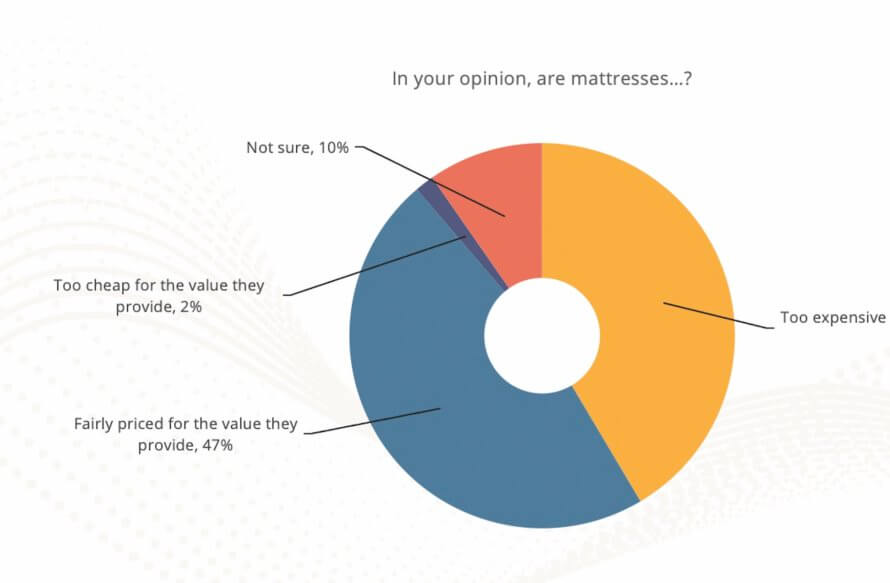How much are consumers willing to spend on a mattress? More than they currently are paying, research shows

Consumers are spending significantly less for queen-size mattresses than they expect to pay, and they are also spending less than they are willing to pay, according to a consumer survey.
The nationally projectible survey was conducted for the Better Sleep Council, the consumer education arm of the International Sleep Products Association, as part of the BSC’s ongoing commitment to consumer research. It found that the bedding industry may be leaving money on the table when consumers shop for mattresses these days.
The research found that consumers actually paid a mean of $915 for a queen-size mattress or set but were willing to pay a mean of $980. And they expected to pay a mean of $1,061.
In addition, the survey found that the price consumers are willing to pay for a queen-size mattress or set varies by age, income, education and location. Older, more affluent and better-educated consumers are willing to pay more for a new mattress than their counterparts.
For example, consumers ages 18 to 35 are willing to pay $750 for a queen mattress, compared with $1,003 for consumers 36 to 55, and $1,102 for consumers 56 and older.
Consumers with incomes of less than $30,000 are willing to pay $649 for a queen mattress, while consumers earning $30,000 to $50,000 are willing to spend $838, consumers earning $50,000 to $100,000 are willing to spend $1,015, and consumers earning more than $100,000 are willing to pay $1,365.
Consumers with less than a college education are willing to spend $805 for a queen mattress, while those with college educations or graduate degrees are willing to spend $1,113 for a queen mattress.
And rural consumers are willing to spend $921 for a queen mattress, while urban consumers are willing to spend $953 and suburban consumers are willing to spend $1,016, the survey found.
“These findings illustrate, once again, that many factors, including age, education and household income, affect how much consumers say they are willing to pay for a new mattress,” said Mary Helen Rogers, vice president of communications and marketing for the ISPA. “This is important information for bedding marketers who want to zero in on their target consumer groups.”
The 2020 figures are comparable to those from 2016, when the BSC conducted a similar study.
In 2016, consumers actually paid a mean of $930 for a queen mattress, $15 more than the 2020 mean. They were willing to pay a mean of $955, $25 less than the 2020 mean. And they expected to pay $1,110, $49 more than the 2020 mean.
The survey also asked consumers about their perceptions of mattress pricing, finding that nearly half of consumers (47%) believe that mattresses are fairly priced for the value they provide. However, four in 10 consumers believe that mattresses are too expensive for the value they provide.
Ten percent of the consumers said they weren’t sure about mattress pricing, while 2% said they were too cheap for the value they provided.
“It’s encouraging to see that almost half of the consumers surveyed believe mattresses are fairly priced,” Rogers said. “But it is worth noting that about 40% of consumers believe mattresses are too expensive. Mattresses come in a wide variety of constructions and price points, so consumers have many choices today. The Better Sleep Council continues to encourage all consumers to invest in a quality mattress, an investment that will pay dividends in years of good sleep, the foundation of good health.”
Consumers Express Satisfaction With Mattress, Shopping Experience
Three in four consumers are satisfied with their current mattress, a Better Sleep Council consumer survey reveals.
The survey found that 42% of consumers reported they are very satisfied with their current mattress, while 34% are somewhat satisfied.
On the other end of the continuum, just 3% of consumers said they were very dissatisfied with their current mattress, with 7% saying they were somewhat dissatisfied. The only other significant category was the 12% of consumers who were neither satisfied nor dissatisfied with their current mattress.
The survey also found that 73% of consumers who recently purchased a mattress said they enjoyed the shopping experience a lot or a little. That finding was comparable to the levels of enjoyment for consumers who recently purchased other furniture or bedding, says the BSC, the consumer education arm of the International Sleep Products Association.
In addition, the survey found that 80% of consumers who recently purchased a mattress felt either very or somewhat knowledgeable about shopping for a mattress.
“These significant levels of consumer satisfaction with their mattress, with the mattress shopping experience and with how knowledgeable they felt while mattress shopping indicate that the mattress industry is meeting many consumers’ needs,” said Mary Helen Rogers, ISPA vice president of communications and marketing. “But the findings also point to key areas where the industry has room for improvement, and identifying those areas is the first step in the improvement process.”
Mattress age and condition
Looking at the mattresses that consumers currently sleep on, the BSC research conducted in 2020 found that 51% of consumers said their mattress is 4 years old or less, with 28% saying their mattress is 5 to 10 years old, and 14% saying their mattress is 11 years old or older. Seven percent said they aren’t sure of the age of their current mattress.
What condition was their previous mattress in? Not very good, said almost one-third of consumers. Six percent said their previous mattress was in very bad condition (deteriorated), while 21% said it was in bad condition.
The biggest group of consumers (36%) described their previous mattress as being in “not so bad condition,” while 25% of consumers said their previous mattress was in good condition, and 11% of consumers said they weren’t sure.
The survey also looked at mattress sizes, finding that 46% of consumers said they are sleeping on a queen mattress, compared with 26% sleeping on a king, 9% sleeping on a California king, 11% sleeping on a full-size mattress and 7% sleeping on a twin.
Foundations and mattress types
The survey found that 59% of consumers said they are using a flat box spring/foundation with their current mattress, with 17% saying they are using a stationary base that is not a box spring/foundation and 16% saying they are using an adjustable foundation.
Almost seven in 10 consumers (68%) said their foundation or base was purchased at the same time as their mattress. Forty-two percent of consumers said they purchased a flat box spring along with their mattress, while 13% purchased an adjustable foundation, another 13% purchased a stationary non-box spring base and 12% said they put their mattress on an existing foundation.
The survey also looked at consumers’ current mattress type, finding that 35% of consumers said they are sleeping on a spring mattress, while 21% are sleeping on a foam mattress without springs or coils, 16% are sleeping on a hybrid mattress made with both springs and foam, 4% are sleeping on an adjustable air chamber mattress, 2% are sleeping on a waterbed and 4% are sleeping on a sofa sleeper.
The survey asked consumers about the types of foams in their mattress. Forty-five percent said memory foam (viscoelastic foam), 18% said gel foam, 15% said latex foam and 32% said they didn’t know.
Mattress purchasing history
The study found that one in two consumers purchased a mattress within the past four years, including 6% who purchased since the Covid-19 pandemic hit.
Most consumers said they purchased their most recent mattress for themselves, and the mattress was purchased at a store (70%), while 26% said it was purchased online.
How many mattresses did consumers purchase in the past 10 years? About four in 10 consumers (41%) said one, with 27% saying two and 14% saying three or more. Fourteen percent of consumers said they have not purchased a mattress in the past decade.







